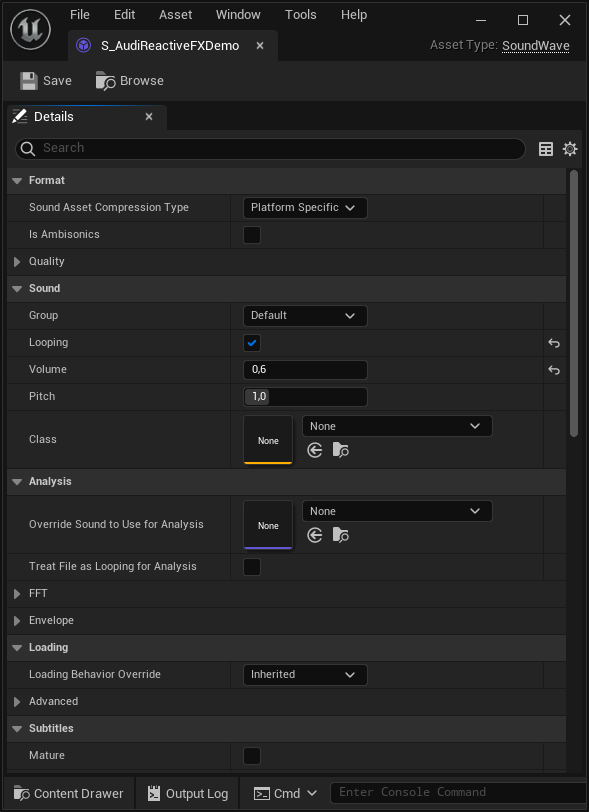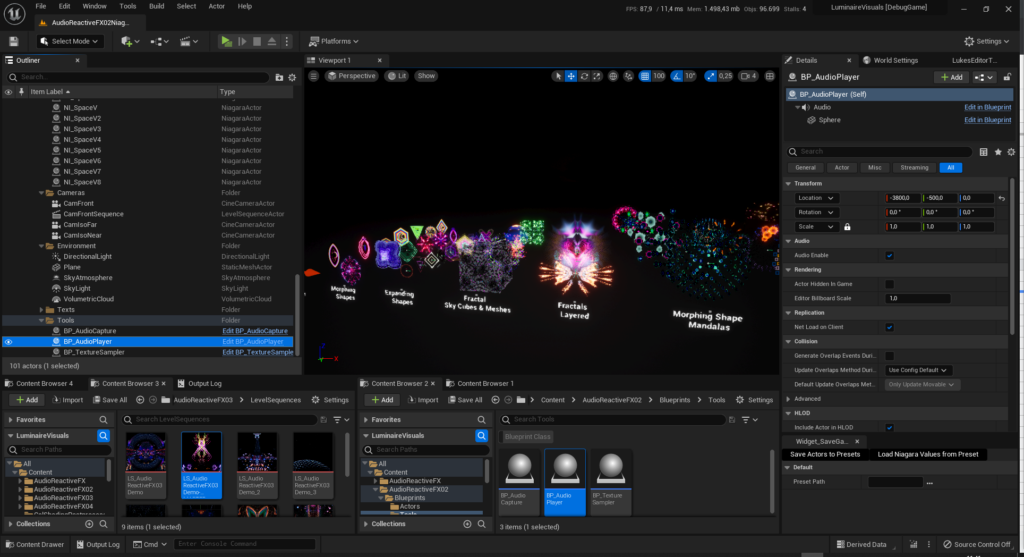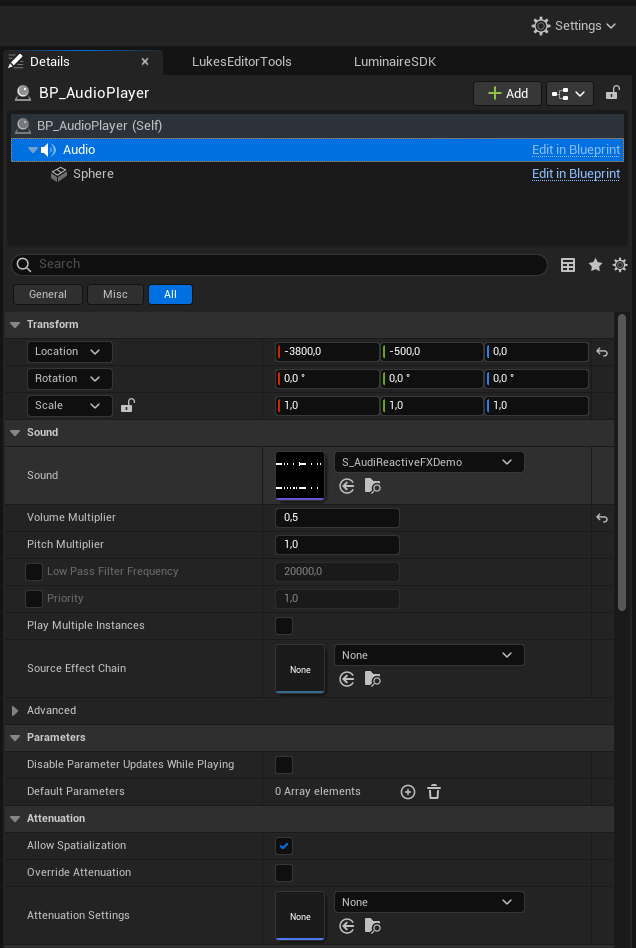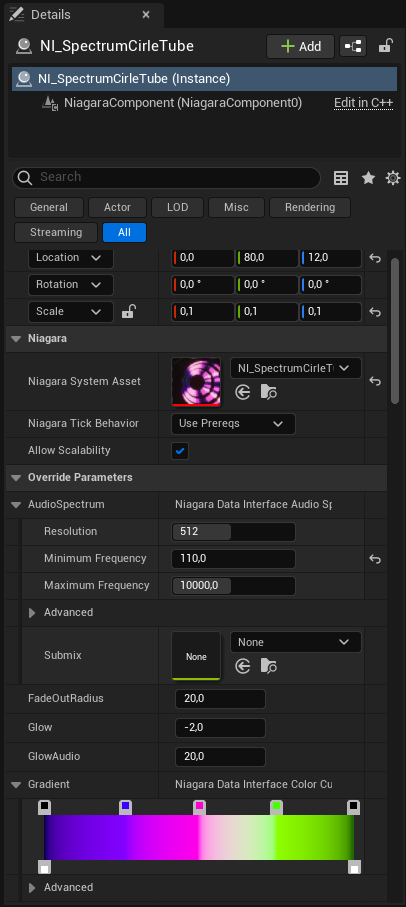Audio Reactive FX 03 is a dynamic Niagara particle effects pack designed to enhance your music experience. With a focus on using textures to create captivating shapes and colors, this asset pack is ideal for live music events or music videos. It offers endless possibilities for customization, allowing you to easily create unique visual effects that are perfectly in sync with your music. The included utility blueprints for audio capture and playback make it simple to add a dynamic and engaging audio-visual element to your performances. Elevate your music and bring your visuals to life with Audio Reactive FX 03.
Unreal Engine Marketplace Link
Audio Reactive FX 03 is an asset pack that offers a comprehensive collection of 34 Niagara particle effects. This modular asset pack is built with versatility in mind, providing you with a wealth of additional Niagara modules, materials, and material functions that can be easily reused. The effect materials are procedurally generated, which means that you can replace meshes with ease, without worrying about UV mapping. With its full feature list, Audio Reactive FX 03 is the perfect tool for creating stunning visual effects that perfectly complement your music.
Example Videos
Check out the full potential of Audio Reactive FX 03 by visiting our YouTube channel, where you can see a collection of mesmerizing video examples using these assets.
Demo Video
Overview video
Features
- 41 Niagara systems (7 Basic & 34 Variations). Each of them having between 20 and 90 parameters for styling.
- 3 Blueprint Tools: audio capture, audio playback, sample texture from material
- 21 reusable Niagara module scripts
- 10 Materials
- 18 Material Instances
- 21 Material functions
- 11 Meshes. Very basic shapes. You can add your own
- 50 Color Curves
- 5 Textures. Example patterns used by the effects
- The majority of parameters (except things like materials) can be animated in the sequencer.
- Audio reactions include: color gradient, emissive, size change, wave motions, animation speed change
- Most effect have a fixed number of particles. No surprise bursts that drag down performance.
- Most effects run on GPU. Exceptions are ribbon systems as they require CPU access
- Blueprint for audio capture actor. Simply put in your map to enable audio capture. Capture can use everything that is heard or use specific audio mix. Thus it can be enabled for music only or voice chat only etc.
- Blueprint for audio playback that plays automatically in editor and game.
- Blueprint to sample a procedural material to a texture.
Setup
Installation & Contents
After downloading the asset pack. Create a new project or add it to an existing project via the Epic Games Launcher. In both cases you will get a “AudioReactiveFX03” folder in your project which contains the following folders
- Blueprints/Tools: contains the 3 tool actors
- Blueprints/Actors: create the effect variations. use these in your maps or make new ones
- LevelSequences: contains the level sequences which were used to render the previews
- Maps: contains 2 maps. The first map contains all effects, created from it’s base Niagara System. In the second map, each effect is replaced by a Blueprint that holds the base Niagara system and has all settings for the unique variation of the effect. If you want to use the effects in a packaged build, use the effects from the 2nd map.
- Materials: contains materials that are used by the effect assets as well as the used material functions, material instances and color curves
- Meshes: contains the used meshes
- Niagara: contains the actual effects which are Niagara systems. also contains Niagara module scripts
- Sounds: contains a short demo sound loop payed on the demo map
How to use the effects
The Maps folder in Audio Reactive FX 03 contains examples of how to use the assets effectively. Each audio-reactive asset has a parameter called AudioSpectrum, which allows you to choose the audio submix that the effect will respond to. Submixes are essentially different audio channels that can provide different audio sources, such as music, sound effects, or voice chat. If no submix is selected, the effect will respond to the project’s master submix by default. If your project is newly created or has its default settings, this means that the effects will respond to all in-game audio.
The demo maps include an instance of the “BP_AudioPlayer,” which plays a short loop of music so that you can hear the effects respond when the map is opened. If you’d like to remove the sound, simply select the “BP_AudioPlayer” actor in the map, choose its audio component, and clear the Sound property.
How to enable audio react from microphone & line-in
- Connect a microphone to your PC (USB or audio plug) or connect an audio source to your PCs line in.
- Open up your project in Unreal Editor or create a new project.
- Drag an “BP_AudioCapture” from the Blueprints/Tools folder into the map. This will instantly enable enable audio capture. This means if you have a microphone connected, the effect should react to your voice. If you have an external audio source on the line in, the effect should react to it. Note that both are possible simultaneously.
- place the audio reactive effects you want in your map. they should now all react to the captured audio.
How to enable audio react from your own audio file
- Open up your project in Unreal Editor or create a new project.
- Add your audio to the project. To do this, drag a supported audio file (WAV, Ogg-Vorbis, AIFF or FLAC) from your file browser into the content browser. You should now have a SoundWave asset in your content browser.
- If you want to make the sound looping, right click the SoundWave asset and select “Edit…”. This opens up the sounds settings like in the following image. Check the “Looping” checkbox and save the SoundWave asset.

- Now drag the “BP_AudioPlayer” blueprint from the content browser into your map. This will create a “BP_AudioPlayer” actor in the map.
- Select the newly created “BP_AudioPlayer” actor in the map like in this picture, showing the demo map. You can select it in the viewport or from the outliner window. (Note that the image shows effects from another pack)

- Now you will see the BP_AudioPlayer’s details in the details panel of the editor like shown in the following image.
- Select the “Audio” component in the details panel like shown in the image. Note the “is UISound” checkbox. If this is enabled, it is always played like a global background sound. This is enabled by default. When disabled the playback has to be started manually. This can be triggered from blueprint, c++ code or other editor tools like the sequencer.

- To set your own audio you can either drag the previously created SoundWave asset from the content browser to the “Sound” property or you can open the dropdown and select one of the supported assets there. The next two images show both ways.
- Once you have set your own audio it will start to play (when the “Is UISound” checkbox is still checked). When the sound is set to be looping, it will play in endless-loop.
- if it does not start to auto play the audio, check the “Is Playing” checkbox of the AudioAnalysisTool actor.
How to enable audio react from in-game sounds
To make the effects respond to in-game sounds like sound effects and music, you’ll need to select the appropriate audio submix. This can be done in the Details panel of the effect. To access the panel, select the effect in the map (either in the viewport or in the Outliner), and navigate to the “Override Parameters” section. Once there, expand the “AudioSpectrum” property to reveal the “Submix” parameter. From there, you can select the desired submix, and the effect will respond to the corresponding audio source.

- If you play all music and sounds without a submix set (empty property) or with the project’s default submix, then you don’t need to change the submixes on the audio reactive effects. You can leave the submix parameter inside the AudioSpectrum property of the effect empty and it will automatically listen on the project’s default submix.
- If you divide your ingame audio into different submixes like music, sound effects, voice chat etc. you will need to set the correct submix in the submix parameter inside the AudioSpectrum property of the effect. For instance if you have a MusicSubmix for background music, you can set this MusicSubmix and enable the effect to react to the background music only.
If the effects do not react to audio
- ensure that there is audio in game. you can use the AudioAnalysisTool to playback sounds or to capture audio (see the previous sections)
- check the submixes of the effects. select the effects and expand the AudioSpectrum property. There is a submix parameter. If this is empty, the effect will listen to the master submix that is set in the audio section of the project settings.
- if multiple submixes are used in the game, be sure to select the correct submix for the effects and also be sure that the actual audio sources like music and sound effects send to the correct submix
Common effect parameters
There are some common effect parameters, that are shared by most of the effects. These are
- AudioSpectrum: defines the submix to analyse, spectrum resolution, min and max frequency
- AudioThreshold: the audio amplitude needs to exceed this threshold to have a visual effect. set this to 0.1 or 0.2 to cancel low volume noise if needed
- GradientIndex OR ColorGradient: defines which gradient to use. See the “CurveAtlas_Color_01” in the “Materials/ColorCurves” folder to get the order of gradients. When new gradients are added, change the “NumberOfCurveAtlasCurves” in the “MPC_GlobalMaterialParameters” asset in the “Materials/MaterialParameterCollections” to be the same number as the number of gradients in the atlas. If this is not done, some of the effects might take the wrong gradients.
- GradientMinimum & GradientMaximum: when these are present, they can be used to stretch the used gradient to better fit the audio.
- SpectrumRangeStart & SpectrumRangeEnd: use to set the range of the spectrum analyzer, where 0 corresponds to the MinimumFrequency and 1 to the MaximumFrequency
- Parameters with “Emissive”,”Glow” or “Brightness” have an effect on the glow behavior
- Parameters that start with “SpectrumTo”, or end with “FromAudio” control the effect of the audio spectrum on various other parameters
Note that parameters that end on “_RESET” will need to reset or rebuild the actor ingame if changed at runtime. Otherwise the parameter change will not take effect. You can ignore this if you do not change the parameters at runtime in a packaged build.
Some effects are based on one of the contained Niagara emitters in the Emitters folder. These can be used to create similar effects.
Contained Assets
Tools
- BP_AudioCapture: starts capturing audio from external sources as line-in or microphone when added to the world. Effects can react to the audio.
- BP_AudioPlayer: starts playback of an audio file when added to the world. Effects can react to the audio.
- BP_TextureSampler: When selected in the map, a source material can be set in the details, as well as a target render target. In addition , there is a button in the details to render the material to the render target. this can be used to “bake” complicated materials to textures.
NI_FloatingShapes
Creates intricate patterns using a collection of different meshes. This effect gives you the ability to enable left-right and up-down mirroring for added versatility. Gray-scale textures are used to define the type of mesh in 2D space, its coloring, and the audio frequency it will respond to. The meshes can move in a designated direction, shrink to zero size at the edges of a defined box and then reappear on the other side. Additionally, you can add a trail effect behind the meshes. The meshes can easily be swapped out with others, and if you’d like to use textured meshes, you can reference the materials used in the asset pack to implement audio reactions into your own materials. This typically involves using a particle color node and dynamic parameter nodes.
NI_FloatingShapes2D
This asset is similar to “NI_FloatingShapes,” but instead uses 2D planes as the meshes. These meshes are then rendered using procedural materials to create shapes such as triangles, circles, or hexagons. If you prefer to use 2D sprites instead of 3D meshes, this asset may be a better fit for your needs. The materials used are more complex, but you can utilize the nodes in these materials to create your own procedural materials.
NI_FloatingShapesIce
The “NI_RotatingShapes” asset offers a variation of “NI_FloatingShapes” by adding rotation to the meshes. This rotation is also mirrored. The 3D meshes in this asset use a procedural material similar to the one used in “NI_FloatingShapes2D,” giving them a Tron-like appearance. Unlike the other systems, this asset does not include the option for a trail.
NI_RiverOfMeshes
This asset creates a grid-like pattern with 3D meshes that move in a single direction. The gray scale textures are used to determine the type of mesh, color, size, height, and audio frequency reaction. There is an option to add platforms underneath the meshes and to elevate or lower the objects towards the edges. Additionally, it supports animated textures, which includes video textures (in grayscale) or animated procedural textures. When using animated textures, it’s recommended to set the movement to 0 so that only the texture animation is visible.
NI_SineWormsGPU
This asset generates trails made of either meshes or sprites. The trails move in a wave-like pattern, with the option to stack multiple sine functions for more complex designs. The trails are mirrored on the x-axis and react to various audio frequencies, allowing for added variety in the trails’ movement. You can also customize the color, width, speed, and length of the trails.
NI_SineWormsRibbons
Same as “NI_SineWormsGPU” but uses ribbon renderers to draw the trails. This forces the system to be evaluated on the CPU as GPU processing is not supported for ribbons at the moment.
NI_TorusFlow
This asset generates particle meshes on torus shapes. The toruses have the ability to rotate, move in a specific direction, and exhibit wave movement. The particles can be manipulated to give the appearance of the torus turning inside out. The appearance of the particle meshes, such as their type, color, size, and audio react frequency, can be defined using gray scale textures. There are various parameters available for customizing the effect, including the ability to use your own meshes. If you prefer to use a different material, you can examine the material used in the asset and copy the particle color and dynamic property nodes. Then, connect these nodes to the material properties you want to modify through audio reaction, allowing for the use of other assets from the marketplace.





